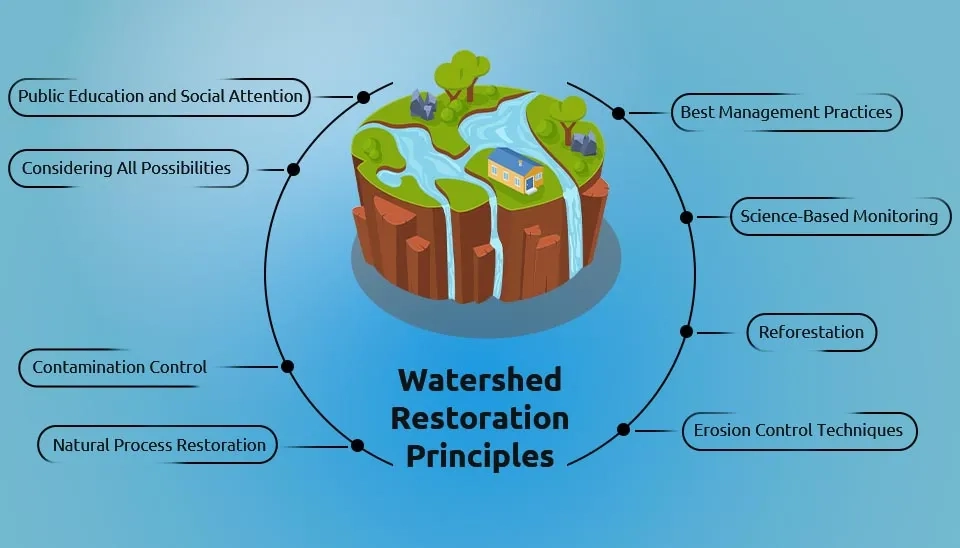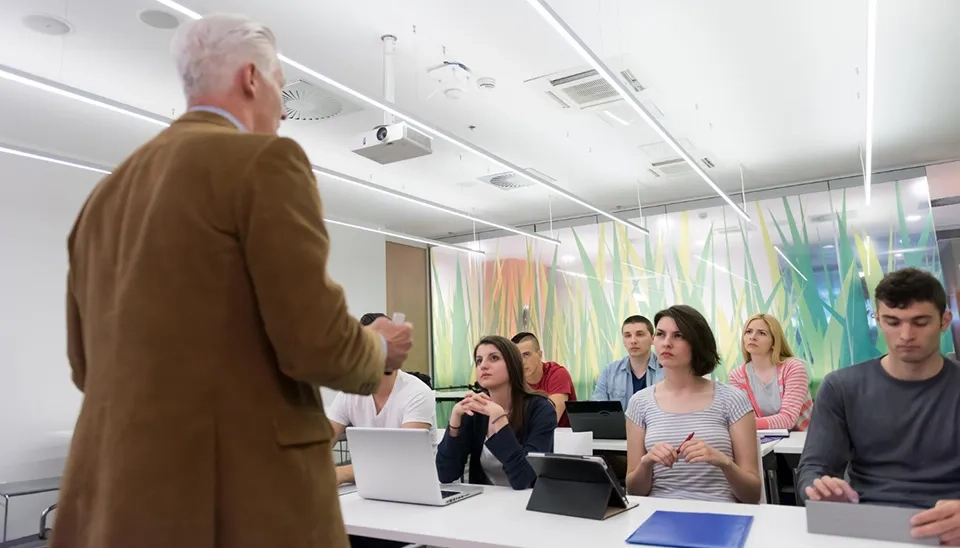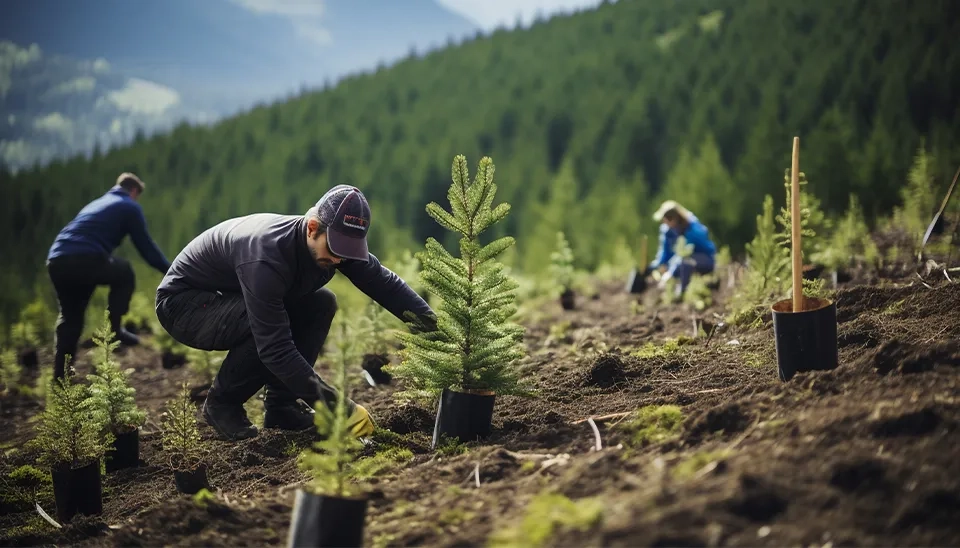
Due to growing anthropogenic pressures that degrade water quality throughout the world, watersheds are becoming more and more of an environmental issue. The world’s 230 watersheds have critical functions in providing water to ecosystems and human communities. In the last century, human technical and engineering capacity has grown sharply enough that it allows us to modify rivers and watersheds to meet waterway demand, generate electricity, or keep humans safe. Due to this, watersheds have been severely regulated and affected. These actions have had a significant impact on the river basins and watersheds, with more adverse effects than expected. Unfortunately, humans have been negatively affecting water quality in the world for a number of reasons, such as numerous rivers becoming polluted and many marine ecosystems have degraded habitat or reduced fisheries (Bernathardt et al., 2005). This widespread degradation underscores the critical importance of understanding why healthy watersheds are essential for ecological balance and human well-being."
There has been a marked increase in the popularity and practice in watershed restoration over the past two decades. Yet, the social and environmental outcomes of restoration remain ambiguous and critics charge that restoration has not fulfilled its promise. Two main questions are addressed in this research:
1) What are the watershed restoration principles?
2) Which methods can be used for watershed restoration?

1. Watershed Restoration Principles
Many studies focus on recent advances in the current and future challenges and perspectives of watershed restoration, rehabilitation, and conservation; approaches to water quality monitoring; perceptions and social understanding of environmental disasters, along with case-study-based learning from specific events; studies that encompass bodies of ecological knowledge pivotal to successful restoration; system dynamics, scale and context-dependency, and diversity; interactions of physical processes (hydrological and geomorphic) with ecological processes and forestry activities; impacts and restoration efforts of changing flood characteristics, managing sediment delivery, altering riparian vegetation, and managing channel integrity (Assireu et al., 2022).
Some practices, such as educational programs for the public and school children, water conservation projects to reduce harmful activities, and upland projects focused on changing land use patterns, are not well represented. As a result, the restoration activities are mainly limited to repairing streams and re-routing sediment at particular sites in spite of broad objectives such as addressing watershed-scale ecological processes and social problems.

1.1. Public Education and Social Attention
The disconnect between restoration goals and practice is closely related to a lack of attention to the social, political, and economic drivers of watershed degradation. Water quantity and flow levels in some rivers are examples of a larger, and critical watershed problem that is currently not being addressed by restoration practices. In order to create sustainable ecosystems and equitable policies, restoration must address social and environmental forces that interact with watershed conditions. Efforts to protect upland habitats from harmful land use activities must also be part of the watershed restoration process. Reducing sprawl and agricultural conversion in the uplands would both decrease the demand for water and preserve remnant upland habitats (Christian-Smith & Merenlender, 2010).

1.2. Considering All Possibilities
Before making costly decisions on how to spend limited restoration budgets, managers could use predictive tools to assess potential outcomes. Managers should also consider all possible sources of change in the landscape, in addition to possible impacts of current and planned watershed restoration activities (Fullerton et al., 2009). Efforts may be useless if they are only based on the proposed watershed restoration strategies without considering other possible factors.
1.3. Contamination Control
As a result of the contamination caused by human activities, many watersheds are polluted as water sources for consumption purposes all around the world. This also damages the water's economic value. Contamination can result from a number of sources, including pesticides and nutrient run-off, pathogens, and erosions leading to sedimentation or salinity (Townsend et al., 2012) (If you want to know more about sources of watershed contamination, click here). For example, to control salinity, there are two main approaches: Changes to land management, and interventions based on engineering approaches. In simple terms, salinity is induced by the clearing of deep-rooted perennial natural vegetation (Peck & Hatton, 2002). The switch from annual to perennial pasture plants can also change the salinity balance (Ward et al., 2002). Engineering approaches could include, for example, the diversion of saline water into a diversion dam and the subsequent disposal of the water through pipelines or desalinated water. Assessing the cost of carrying out such amelioration can help the valuation of salinity reduction and therefore, the water quality improvement services that watershed reforestation can provide.

1.4. Natural Process Restoration
The general view is that watershed restoration should primarily focus on restoring natural processes that create and maintain habitats rather than overestimating instream habitats. However, most process-based restoration is site-specific, that is, conducted on a short stream. Unfortunately, only a few techniques to restore watershed and stream habitats have been thoroughly assessed, such as instream structure placement, riparian plantings, road restoration, and reconnection of isolated habitats. However, their effectiveness is highly debated amongresearcherss and the scientific community. Furthermore, the recommendations are dependent upon a watershed assessment and in no way diminish the need for proper assessment of processes and current conditions in a watershed. It is vital to prioritize protecting high-quality habitats over restoring habitats since it is much simpler and more successful to maintain good habitats than trying to recreate or restore degraded habitats (Roni et al., 2002).

1.5. Best Management Practices
Implementation of watershed-based management strategies often results in the rehabilitation of surface waters that have been degraded due to urbanization. Best Management Practices (BMPs) are the predominant methods used to restore urban watersheds and achieve downstream water quality goals. However, a significant upfront and recurrent cost can be incurred in the implementation of BMPs. There is limited funding for water quality programs, and in many cases, they must compete with other municipal priorities. Therefore, it is necessary to choose the most appropriate and cost-effective practices in a given watershed, considering feasibility, site constraints, and size. The evaluation of the watershed restoration strategy could greatly benefit from tools combining simulation with cost estimation and optimization to form a simulation optimization framework. By identifying the most cost-effective watershed improvement strategies, funding for watershed restoration can be stretched (Alamdari & Sample, 2019).

1.6. Science-Based Monitoring
Restoration is typically limited to the mitigation of stresses by optimizing water use, floodplain excavation, and active revegetation. The success of future projects can be improved through science-based monitoring of existing projects to better understand hydrologic effects on key biological and physical variables during different water years. Future designs and site selections may benefit from this monitoring. In addition, adaptive management is becoming increasingly important. To ensure that desired ecosystem services can be maintained under climate change constraints, managers might need to implement innovative measures. However, because the experimental nature of restoration is not expressly acknowledged, monitoring is often not set up to test hypotheses and assumptions about restoration that can inform future planning and implementation. Therefore, durable restoration success may take many years to decades to evaluate (Ralston & Sarr, 2017).
1.7. Reforestation
The impact of reforestation on water supplies is often considered in terms of impacts on water yields. In particular, reforestation can increase and improve the quality of water in a situation where it is possible to utilize previously unusable water. Although reforestation can help restore the watershed, it is rarely implemented due to many concerns. These include concern about decreasing water yield and lack of funding to implement large-scale reforestation in watersheds at the level that is needed to improve water quality, lack of interest in changing land management practices by private landholders, and a policy or regulatory environment that prevents payments for environmental services from reforestation, or creates barriers to changes in land-use (Harper et al., 2012).

1.8. Erosion Control Techniques
Soil degradation has not received much attention compared to threats to other elements, although soils are as important to human society as air and water. Erosion by water occurs due to the energy of water as it falls to earth and flows over the surface. The concept of erosion control, depending on the scale of the activity, could be understood as single, on a small area, or a watershed scale. On a scale of a watershed, erosion control is a part of whole watershed management planning. The categories of measures for erosion control are as follows: technology ameliorating measures; hydraulic structures; and Administrative and educative measures. The purposes of the technical improvement are: to reduce surface water pollution, to store water, to reduce erosion on hills, etc. Implementing erosion control techniques will lead to better watershed restoration (Blinkov et al., 2013)
2. Conclusion
As restoration practitioners and as a society, we will benefit from increased adoption of more flexible, processed-based approaches, allowing watersheds to adapt to what may come. Real solutions will only be found when restoration looks beyond the stream to address the entire watershed as a combination of social and ecological forces that interact to produce watershed conditions. Bridging the disconnect between restoration goals and practices will require better coordination among agencies involved in restoration to focus on larger, watershed-scale concerns. In combination, information about expected future trends and projected effects of restoration can inform the decision-making process and ensure that funds are spent on the most efficient suite of restoration or conservation projects. According to this paper, watershed restoration programs seek to restore degraded watersheds in different areas to increase their capacity to capture and store water, reduce water pollution, repair the source of water damage, and improve water quality.
Although there is much work to be done on the topic of this special issue, we hope that readers can benefit from the insights provided by these papers and that the highlights presented in this Special Issue can attract attention to pursue further investigations and meaningful developments in watershed restoration.
